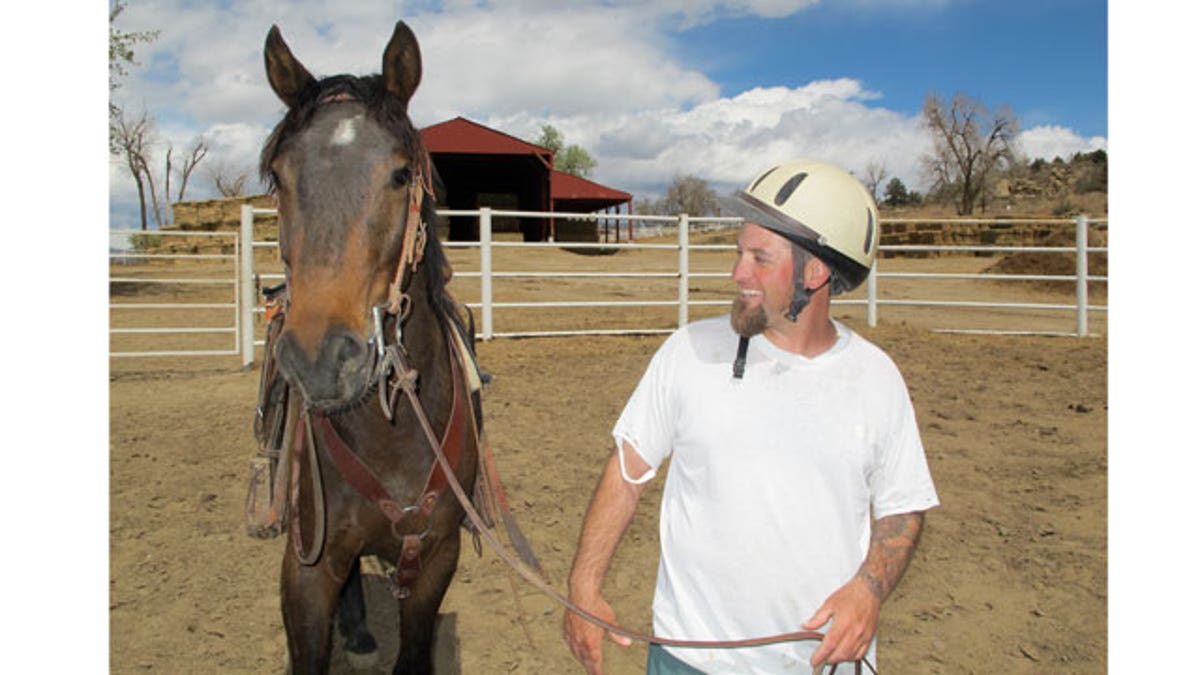
James Hershey, Prison Inmate and Horse Trainer
It’s been 25 years since the Bureau of Land Management decided to speed up adoptions of wild horses by using prison inmates to train them. Since then nearly 5,000 animals have been gentled or saddle trained in the Wild Horse Inmate Program and adopted out.
Fran Ackley, who runs the BLM wild horse facility outside of Canon City, Colo., says the U.S. Border Patrol buys many of the inmate-trained horses.
“American mustangs working to protect America's borders, it just seems like a natural fit. We've adopted 95 horses to the U.S. Border Patrol, mostly on the southern border, but we have almost 30 horses on the northern border as well.”
Agents on horseback can patrol remote terrain where motorized vehicles just can’t get. And when it comes to horses, Mustangs bred in the wild are toughest and most sure-footed there are.
That’s why, Ackley says, they are the preferred choice of the Border Patrol. “They really like the quality of the horses (and) they use them all day, every day. And they can handle it: they're durable, they don't give out, they have really tough feet.”
With the nation’s renewed emphasis on border security, the Border Patrol plans to increase the use of horse patrols. Another 70 Wild Horse Inmate Program (WHIP) animals are on order.
Using inmates to do the training saves taxpayers money in several ways. Saddle-trained WHIP animals cost $1,025 each. That’s about the same as it would cost to lease a comparable horse for a year, and less than half what it would cost to buy one from a private seller.
And trained horses not bought by the Border Patrol are much more likely to get adopted by members of the general public. In 2010, more than 40 percent of the BLM’s $64-million Wild Horse and Burro budget went to the care and feeding of animals that no one would adopt. Taxpayers no longer have to pay for animals adopted out. Untrained horses can be adopted for just $125, but takers for unbroken horses are much harder to find.
For the inmates doing the WHIP training, “It’s a little piece of freedom every day,” according to James Hershey who says he’s doing a 4-year stretch for drugs in the nearby Four Mile Correctional Facility.
“It is very relaxing, and rewarding. You see a change in their eye from when…they're a completely wild animal, to the point where they trust you. (Then) you can see a softness in their eye.”
The aptly named Cody West manages the inmate side of the program. “Horse training's not for everybody,” he says while explaining that not all inmates make the grade.
“They have to be patient. At the same time they have to be brave. There's a certain kind of risk you take anytime you get around one of these animals.”
A fact attested to by inmate Timothy Schoenleder. “I been bit, kicked, stomped, you name it. It's not if you get hurt, it's when you get hurt, 'cus you will. They're scared. It's fight or flight. In their world everything's out to eat them. Once they learn that you're not out to eat them then they're all right, then they're like big babies.”
On the outside Schoenleder rides a Harley instead of a horse. “It’s a lot different. A motorcycle you can control. A horse sometimes you can’t.”
But still to him working with horses is a kind of therapy. “I was out here before (in prison) and I got out in 2007. Then I screwed up and came back with a little trespassing charge. When I got out I didn’t miss the place, but I missed the horses. I love it out here (working with the animals).”
The horse training inmates all come from minimum security facilities. It’s a privilege they have to earn. Interestingly, most have never trained horses before, which is how West likes it.
“I'd prefer them not to have any horse experience because then I don't have to break any bad habits. They come in here green, and I can show them how we want it to be done, and it works out a whole lot better.”
West says the number one quality in a good horse trainer is something that doesn’t come naturally to people who land behind bars.
“Patience more than anything, nothing happens in horse training in a fast pace.”
Consequently, inmate trainers tend to learn as much from the horses as they horses learn from them.
“It teaches me patience and how to just relax and think about what I'm doing,” says Ramon “Gonzo” Gonzales, serving a three-year sentence for 2nd degree burglary, as he dismounts a three-year-old Palomino named Ringo.
“He’s close to being done. He’s going to be going to the Border Patrol here within the next month. Seeing them come out of the wild and then come to be like this…that’s really rewarding.”
West says wild horses train pretty much the same as others except in the beginning.
“They come in and they’re three years old and they’ve never been handled, where most domestic horses have been handled since six months of age. So that first two weeks we just have to build some trust with them and let them know we’re not going to hurt them.”
The Border Patrol gives some additional training to the mustangs it buys from WHIP. It includes getting them used to the firing of a weapon, helicopters flying overhead and other things specific to their news job securing America’s borders.





















